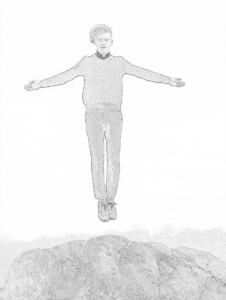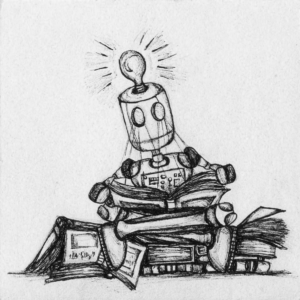With the exception of Nietzsche, no other madman has contributed so much to human sanity as has Louis Althusser. He is mentioned twice in the Encyclopaedia Britannica as someone’s teacher. There could be no greater lapse: for two important decades (the 60s and the 70s), Althusser was at the eye of all the important cultural storms. He fathered quite a few of them.
This newly-found obscurity forces me to summarize his work before suggesting a few (minor) modifications to it.
(1) Society consists of practices: economic, political and ideological.
Althusser defines a practice as:
“Any process of transformation of a determinate product, affected
by a determinate human labour, using determinate means (of production)”
The economic practice (the historically specific mode of production) transforms raw materials to finished products using human labour and other means of production, all organized within defined webs of inter-relations. The political practice does the same with social relations as the raw materials. Finally, ideology is the transformation of the way that a subject relates to his real life conditions of existence.
This is a rejection of the mechanistic worldview (replete with bases and superstructures). It is a rejection of the Marxist theorization of ideology. It is a rejection of the Hegelian fascist “social totality”. It is a dynamic, revealing, modern day model.
In it, the very existence and reproduction of the social base (not merely its expression) is dependent upon the social superstructure. The superstructure is “relatively autonomous” and ideology has a central part in it – see entry about Marx and Engels and entry concerning Hegel.
The economic structure is determinant but another structure could be dominant, depending on the historical conjuncture. Determination (now called over-determination – see Note) specifies the form of economic production upon which the dominant practice depends. Put otherwise: the economic is determinant not because the practices of the social formation (political and ideological) are the social formation’s expressive epiphenomena – but because it determines WHICH of them is dominant.
(2) People relate to the conditions of existence through the practice of ideology. Contradictions are smoothed over and (real) problems are offered false (though seemingly true) solutions. Thus, ideology has a realistic dimension – and a dimension of representations (myths, concepts, ideas, images). There is (harsh, conflicting) reality – and the way that we represent it both to ourselves and to others.
(3) To achieve the above, ideology must not be seen to err or, worse, remain speechless. It, therefore, confronts and poses (to itself) only answerable questions. This way, it remains confined to a fabulous, legendary, contradiction-free domain. It ignores other questions altogether.
(4) Althusser introduced the concept of “The Problematic”:
“The objective internal reference … the system of questions
commanding the answers given”
It determines which problems, questions and answers are part of the game – and which should be blacklisted and never as much as mentioned. It is a structure of theory (ideology), a framework and the repertoire of discourses which – ultimately – yield a text or a practice. All the rest is excluded.
It, therefore, becomes clear that what is omitted is of no less importance than what is included in a text. The problematic of a text relates to its historical context (“moment”) by incorporating both: inclusions as well as omissions, presences as much as absences. The problematic of the text fosters the generation of answers to posed questions – and of defective answers to excluded questions.
(5) The task of “scientific” (e.g., Marxist) discourse, of Althusserian critical practice is to deconstruct the problematic, to read through ideology and evidence the real conditions of existence. This is a “symptomatic reading” of TWO TEXTS:
“It divulges the undivulged event in the text that it reads and, in the
same movement, relates to it a different text, present, as a necessary
absence, in the first … (Marx’s reading of Adam Smith) presupposes
the existence of two texts and the measurement of the first against
the second. But what distinguishes this new reading from the old,
is the fact that in the new one, the second text is articulated with the
lapses in the first text … (Marx measures) the problematic contained
in the paradox of an answer which does not correspond to any questions posed.”
Althusser is contrasting the manifest text with a latent text which is the result of the lapses, distortions, silences and absences in the manifest text. The latent text is the “diary of the struggle” of the unposed question to be posed and answered.
(6) Ideology is a practice with lived and material dimensions. It has costumes, rituals, behaviour patterns, ways of thinking. The State employs Ideological Apparatuses (ISAs) to reproduce ideology through practices and productions: (organized) religion, the education system, the family, (organized) politics, the media, the industries of culture.
“All ideology has the function (which defines it) of ‘constructing’
concrete individuals as subjects”
Subjects to what? The answer: to the material practices of the ideology. This (the creation of subjects) is done by the acts of “hailing” or “interpellation”. These are acts of attracting attention (hailing) , forcing the individuals to generate meaning (interpretation) and making them participate in the practice.
These theoretical tools were widely used to analyze the Advertising and the film industries.
The ideology of consumption (which is, undeniably, the most material of all practices) uses advertising to transform individuals to subjects (=to consumers). It uses advertising to interpellate them. The advertisements attract attention, force people to introduce meaning to them and, as a result, to consume. The most famous example is the use of “People like you (buy this or do that)” in ads. The reader / viewer is interpellated both as an individual (“you”) and as a member of a group (“people like…”). He occupies the empty (imaginary) space of the “you” in the ad. This is ideological “misrecognition”. First, many others misrecognize themselves as that “you” (an impossibility in the real world). Secondly, the misrecognized “you” exists only in the ad because it was created by it, it has no real world correlate.
The reader or viewer of the ad is transformed into the subject of (and subject to) the material practice of the ideology (consumption, in this case).
Althusser was a Marxist. The dominant mode of production in his days (and even more so today) was capitalism. His implied criticism of the material dimensions of ideological practices should be taken with more than a grain of salt. Interpellated by the ideology of Marxism himself, he generalized on his personal experience and described ideologies as infallible, omnipotent, ever successful. Ideologies, to him, were impeccably functioning machines which can always be relied upon to reproduce subjects with all the habits and thought patterns required by the dominant mode of production.
And this is where Althusser fails, trapped by dogmatism and more than a touch of paranoia. He neglects to treat two all-important questions (his problematic may have not allowed it):
(a) What do ideologies look for? Why do they engage in their practice? What is the ultimate goal?
(b) What happens in a pluralistic environment rich in competing ideologies?
Althusser stipulates the existence of two texts, manifest and hidden. The latter co-exists with the former, very much as a black figure defines its white background. The background is also a figure and it is only arbitrarily – the result of historical conditioning – that we bestow a preferred status upon the one. The latent text can be extracted from the manifest one by listening to the absences, the lapses and the silences in the manifest text.
But: what dictates the laws of extraction? how do we know that the latent text thus exposed is THE right one? Surely, there must exist a procedure of comparison, authentication and verification of the latent text?
A comparison of the resulting latent text to the manifest text from which it was extracted would be futile because it would be recursive. This is not even a process of iteration. It is teutological. There must exist a THIRD, “master-text”, a privileged text, historically invariant, reliable, unequivocal (indifferent to interpretation-frameworks), universally accessible, atemporal and non-spatial. This third text is COMPLETE in the sense that it includes both the manifest and the latent. Actually, it should include all the possible texts (a LIBRARY function). The historical moment will determine which of them will be manifest and which latent, according to the needs of the mode of production and the various practices. Not all these texts will be conscious and accessible to the individual but such a text would embody and dictate the rules of comparison between the manifest text and ITSELF (the Third Text) , being the COMPLETE text.
Only through a comparison between a partial text and a complete text can the deficiencies of the partial text be exposed. A comparison between partial texts will yield no certain results and a comparison between the text and itself (as Althusser suggests) is absolutely meaningless.
This Third Text is the human psyche. We constantly compare texts that we read to this Third Text, a copy of which we all carry with us. We are unaware of most of the texts incorporated in this master text of ours. When faced with a manifest text which is new to us, we first “download” the “rules of comparison (engagement)”. We sift through the manifest text. We compare it to our COMPLETE master text and see which parts are missing. These constitute the latent text. The manifest text serves as a trigger which brings to our consciousness appropriate and relevant portions of the Third Text. It also generates the latent text in us.
If this sounds familiar it is because this pattern of confronting (the manifest text), comparing (with our master text) and storing the results (the latent text and the manifest text are brought to consciousness) – is used by mother nature itself. The DNA is such a “Master Text, Third Text”. It includes all the genetic-biological texts some manifest, some latent. Only stimuli in its environment (=a manifest text) can provoke it to generate its own (hitherto latent) “text”. The same would apply to computer applications.
The Third Text, therefore, has an invariant nature (it includes all possible texts) – and, yet, is changeable by interacting with manifest texts. This contradiction is only apparent. The Third Text does not change – only different parts of it are brought to our awareness as a result of the interaction with the manifest text. We can also safely say that one does not need to be an Althusserian critic or engage in “scientific” discourse to deconstruct the problematic. Every reader of text immediately and always deconstructs it. The very act of reading involves comparison with the Third Text which inevitably leads to the generation of a latent text.
And this precisely is why some interpellations fail. The subject deconstructs every message even if he is not trained in critical practice. He is interpellated or fails to be interpellated depending on what latent message was generated through the comparison with the Third Text. And because the Third Text includes ALL possible texts, the subject is given to numerous competing interpellations offered by many ideologies, mostly at odds with each other. The subject is in an environment of COMPETING INTERPELLATIONS (especially in this day and age of information glut). The failure of one interpellation – normally means the success of another (whose interpellation is based on the latent text generated in the comparison process or on a manifest text of its own, or on a latent text generated by another text).
There are competing ideologies even in the most severe of authoritarian regimes. Sometimes, IASs within the same social formation offer competing ideologies: the political Party, the Church, the Family, the Army, the Media, the Civilian Regime, the Bureaucracy. To assume that interpellations are offered to the potential subjects successively (and not in parallel) defies experience (though it does simplify the thought-system).
Clarifying the HOW, though, does not shed light on the WHY.
Advertising leads to the interpellation of the subject to effect the material practice of consumption. Put more simply: there is money involved. Other ideologies – propagated through organized religions, for instance – lead to prayer. Could this be the material practice that they are looking for? No way. Money, prayer, the very ability to interpellate – they are all representations of power over other human beings. The business concern, the church, the political party, the family, the media, the culture industries – are all looking for the same thing: influence, power, might. Absurdly, interpellation is used to secure one paramount thing: the ability to interpellate. Behind every material practice stands a psychological practice (very much as the Third Text – the psyche – stands behind every text, latent or manifest).
The media could be different: money, spiritual prowess, physical brutality, subtle messages. But everyone (even individuals in their private life) is looking to hail and interpellate others and thus manipulate them to succumb to their material practices. A short sighted view would say that the businessman interpellates in order to make money. But the important question is: what ever for? What drives ideologies to establish material practices and to interpellate people to participate in them and become subjects? The will to power. the wish to be able to interpellate. It is this cyclical nature of Althusser’s teachings (ideologies interpellate in order to be able to interpellate) and his dogmatic approach (ideologies never fail) which doomed his otherwise brilliant observations to oblivion.
In Althusser’s writings the Marxist determination remains as Over-determination. This is a structured articulation of a number of contradictions and determinations (between the practices). This is very reminiscent of Freud’s Dream Theory and of the concept of Superposition in Quantum Mechanics.





